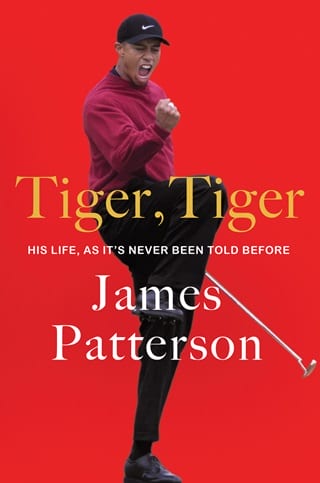Chapter 77
2999 Military Trail
Jupiter, Florida
May 29, 2017
A black Mercedes is stopped in the right lane of Military Trail, a north-south road that runs forty-six miles between Palm Beach and Broward Counties. It’s 2:03 a.m. on Monday, May 29, when Officer Matthew Palladino of the Jupiter Police Department spots the car, which appears to have veered into the bike lane. The brake lights and right turn signal are on; the car is still running but not moving. There’s some damage visible; both driver’s-side tires are flat, and the passenger-side taillight is out.
Officer Palladino approaches the Mercedes. He spots a Black male asleep at the wheel. Once awakened, the man identifies himself as Tiger Woods and groggily manages to hand over his driver’s license, insurance card, and registration.
Through all these tasks, Officer Palladino notes Tiger’s “extremely droopy” eyes, “extremely slow” movements, and his “slurred and mumbled speech.”
Police backup appears, including Officer Christopher Fandrey.
“Where are you coming from?” asks Officer Fandrey.
“L.A.,” replies Tiger. When questioned, he clarifies that he’s on his way down to Orange County in California.
“Do you know where you’re at right now?” asks Officer Fandrey.
“No,” says Tiger. “I have no idea.”
Tiger’s informed that he’s in Jupiter, Florida, about fifteen miles from home. He denies having had anything to drink, but he says he is on medication. Then, complying with police procedure, he exits the vehicle. He’s unsteady on his feet, and his shoes are untied.
“Do you want to tie your shoes?” Officer Fandrey asks.
“No,” Tiger answers. “I can’t get down that far.” He chooses to remove them instead.
Tiger agrees to undergo Standardized Field Sobriety Testing but has trouble following the instructions. Like Officer Palladino, Officer Fandrey notices Tiger’s “extremely droopy” eyes and “dilated” pupils. He’s in a state of confusion. Instead of reciting the alphabet, Tiger thinks he’s been asked “not to sing the national anthem backwards.”
The officers arrest Tiger on suspicion of driving under the influence and double-lock handcuffs around his wrists. Two separate Breathalyzer tests administered at a breath-alcohol testing facility both come up 0.000—detecting no alcohol in his body.
Tiger is handed over to the Palm Beach County jail, then released from custody. On Tuesday, May 30, he issues a statement: “What happened was an unexpected reaction to prescribed medications. I didn’t realize the mix of medications had affected me so strongly.” He’s disappointed in himself. “I would like to apologize with all my heart to my family, friends and the fans. I expect more from myself too.”
Comparisons to Tiger’s November 2009 car accident—and the question of whether he’d been driving under the influence that night, too—are inescapable. Also inescapable is the unflattering booking photo released by the Palm Beach County Sheriff’s Office. Tiger’s heavy-lidded image dominates the news cycle, along with the sensational details of his arrest. One ABC News report includes a stark reminder of Tiger’s current position on the Official World Golf Ranking: 876.
There is no comment from the PGA or from Tiger’s agent, Mark Steinberg (now a partner at Excel Sports Management), but Tiger’s friends rally around him.
“I’m a fan of Tiger’s. I’m a friend of Tiger’s. And I feel bad for him,” says Jack Nicklaus. “I think that he’s struggling. And I wish him well. I hope he gets out of it and I hope he plays golf again. He needs a lot of support from a lot of people… And I’ll be one of them.”
Longtime friend Notah Begay III can especially relate to Tiger’s current situation, unfortunately. The men—whose friendship as junior golfers deepened when they became Stanford teammates and players on the PGA Tour—now share the experience of a DUI arrest. In Begay’s case, two of them. During his second PGA season, in 2000, Begay won two consecutive tour events… and then committed his second DUI offense in five years. After he’d struck a parked car outside an Albuquerque bar, his blood alcohol level was found to be more than twice the legal limit in New Mexico. The incident landed Begay in jail, where he served seven days of a 364-day sentence.
He understood that his actions would forever follow him. “This isn’t the type of incident that’s going to be forgotten quickly,” Begay said upon his release. “It will be written about leading into a story. It will always be a part of my career.”
Begay stopped drinking, and in 2013 he left the PGA Tour to become an analyst for the Golf Channel and NBC Sports. So he speaks from hard-won experience when he says, while broadcasting on the Golf Channel at the NCAA men’s golf championship, “It’s embarrassing for Tiger, something that you can’t go back and change. I’ve been there myself… But it was a turning point in my life. Hopefully, it’s something he’ll learn from, grow from, take responsibility for and use it to make some changes.”
Of Tiger’s latest public downfall, Olympic swimmer Michael Phelps says, knowingly, “I feel like that’s a massive scream for help.”
Phelps won a record-setting number of medals for Team USA in three Olympic Games (five gold and two bronze medals at Athens in 2004; eight golds at Beijing in 2008; and four golds and two silvers at London in 2012) before his own DUI arrest in 2014 and subsequent rehab.
Begay, who’d reached out to Phelps when the swimmer was in treatment, now connects Phelps with Tiger. “Michael can provide honest and direct feedback, and that’s what athletes of their caliber need the most.”
Phelps understands what Tiger is going through. In 2004, shortly after the Olympic Games in Athens, he pleaded guilty to driving under the influence, and ten years later, in 2014, he made the same plea after being stopped exiting a Maryland traffic tunnel driving eighty-four miles per hour.
At the time, Phelps admitted to being “in a really dark place” and “not wanting to be alive anymore.” Forty-five days of inpatient treatment provided the reset he needed, though he admits that in the beginning, “it’s probably the most afraid I’ve ever felt in my life.” Once he came to view rehab as a new competition to crush, he was on his way to staging an inspiring comeback at the 2016 Olympics in Rio, where he won another five golds and one silver.
These days, Phelps speaks publicly about mental health. He offers himself as a private counselor to Tiger. That doesn’t mean the conversations are easy. The two talk “on and off” until, Phelps finds, “there’s more of a comfort level.”
As a new dad to a one-year-old son, Boomer, Phelps feels especially sympathetic about Tiger’s missed family time. “Not having the freedom to see your children whenever you want,” Phelps says—“it’s heartbreaking.”
Elin strongly considers taking legal action against Tiger for breaking a clause in their divorce agreement that prohibits him from causing public scandals, raising the possibility that Tiger would lose shared custody of Sam and Charlie. On June 12, Tiger checks in to the Jupiter Medical Center, reserving the male inpatient unit for his sole use.
“It doesn’t matter whether you’re Tiger Woods or Joe Blow down the street,” says Australian Olympic gold–medal swimmer Grant Hackett, whom Phelps also helped recover from substance abuse and the pressures of fame. “We’re all just people trying to work through stuff.”
A week later, Tiger tweets: I’m currently receiving professional help to manage my medications and the ways that I deal with back pain and a sleep disorder. I want to thank everyone for their amazing outpouring of support and understanding especially the fans and players on tour.
“May 29 shook him up quite a bit, as it should,” Tiger’s agent, Mark Steinberg, tells the New York Times on June 20. “He’s been in just immense pain for so very long that taking prescribed medication was a must, just to be able to get up and move,” Steinberg says, adding the qualifier, “I don’t think it’s fair to say there is an addiction.”
On Monday, July 3, Tiger tweets that he has completed the treatment program, renewing his thanks to all those who have offered their support. He’s next seen on July 29 at the El Clásico soccer match at Hard Rock Stadium. The trip to Miami to watch Spain’s top La Liga rivals, Real Madrid CF versus FC Barcelona—featuring star players Lionel Messi and Luis Suárez—is a special treat for soccer-mad Sam and Charlie.
After Barcelona wins the game, Tiger arranges for a locker-room visit and posts a group photo with Messi and Suárez, all in Barcelona jerseys, while Suárez posts one of just him and Tiger captioned: “Finishing the tour with a victory, also a great photo with an idol !!!!!!!!!”
As they pose with Messi, Tiger says to Sam, “Isn’t it neat to meet a living legend?”
“Yeah. We live with one,” replies Sam.
It’s a surprising reminder that his kids are aware of their dad’s celebrity, even if his last PGA win was four years ago, in August of 2013, when Sam was six and Charlie was four. “Most of the stuff they’ve seen has been on highlight packages,” says Tiger. “I never thought my kids have understood what I’ve been able to do in the game because they always think I’m the ‘YouTube’ golfer.”
It’s a heady night being in the company of top professional athletes at the top of their game. Whatever it takes to get back on the PGA Tour, Tiger is up for it.
“I want them to see what I’ve been able to do my entire career,” he says of his kids and his hopes of playing again. “I want them to come to a few events. I want them to feel it. I want them to understand it a little bit more.
“I recently spoke to my surgeon and he’s very pleased with how my fusion is healing,” Tiger tells the Associated Press. “I’m right on schedule. I’m now doing some light lifting, riding a stationary bike and putting a little.”
But on August 16, the release of the incident report from the Palm Beach County Sheriff’s Office yanks the news cycle back to the events of May 29. The New York Times reports, TIGER WOODS HAD 5 DRUGS IN HIS SYSTEM AFTER ARREST. The list includes Vicodin and Dilaudid (for pain), Xanax (for anxiety), Ambien (for sleep), and THC, the psychoactive ingredient in cannabis.
Tiger’s made a plea deal with Jupiter authorities, who lower the DUI charge to reckless driving (the same conviction he received in 2009) and fine him $250. After an arraignment on October 25, he’ll begin a year of probation, enroll in a community service program, and participate in a “victim impact panel” led by people whose lives have been changed by impaired drivers.
Though there’s some grumbling that Tiger’s gotten a light sentence, “he wasn’t treated differently than anybody else,” the Palm Beach County chief assistant state attorney tells ABC News.
It’s the universal struggle that’s perhaps the most captivating aspect of Tiger’s story. On September 26, the capacity crowd at the Liberty National Golf Club, in Jersey City, New Jersey, cheers at the sight of Tiger riding a golf cart, his friend Notah Begay III at the wheel. The 2017 Presidents Cup opens in two days. Tiger is one of three assistant captains for the American team, reprising a leadership role after last year’s win at the 2016 Ryder Cup.
When Tiger emerges onto the driving range, autograph seekers eagerly approach. As Golf Digest reports, TIGER WOODS, DESPITE YEAR FROM HELL, REMAINS GOLF’S BIGGEST DRAW—even when the tournament’s VIP attendees include three former US presidents (Bill Clinton, George W. Bush, and Barack Obama) as honorary chairmen.
The POTUSes’ joint appearance ahead of the first tee time at the Presidents Cup marks the first time that three former US presidents have attended together. After American team member Phil Mickelson shakes the hands of presidents number 42, 43, and 44, then poses for an impromptu photo, his brother tweets it out under the caption: When you can take a selfie with three US Presidents, you do it!!
Mickelson’s seize-the-day mentality is understandable. Every professional athlete operates with full knowledge that the physical gifts available today could vanish tomorrow, and Tiger’s recent issues serve as a stark reminder.
On October 1, the American team wins the 2017 Presidents Cup 19–11. More history is made when the forty-fifth president, Donald Trump, appears at the final round to hand-deliver the trophy to the winners, the first sitting US president ever to do so.
Despite these notable moments, it’s Tiger who still captures the attention of the media. He dominates the pre-tournament press conference, where reporters direct the majority of their questions to the assistant captain.
“Why do you need competitive golf still?” asks Karen Crouse of the New York Times.
Tiger pauses before offering the noncommittal answer, “I think it’s fun.”
Alex Miceli, veteran golf writer and founder of Golf.com, digs deeper, asking, “Could you see a scenario where you could not come back?”
That’s when Tiger delivers an answer that lingers throughout the offseason.
“Yeah, definitely,” he says. “I don’t know what my future holds for me.”
 Fullepub
Fullepub 



